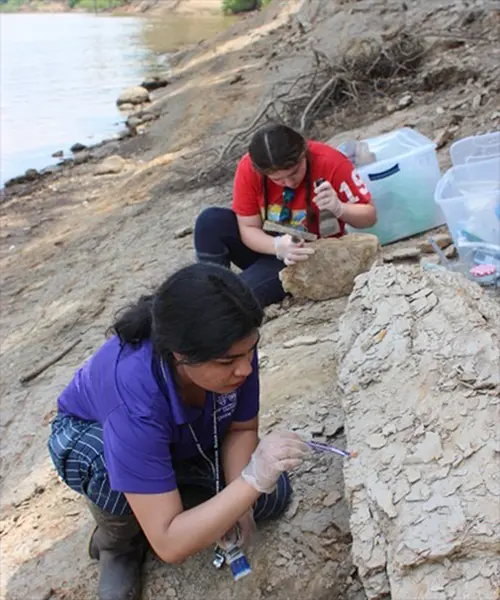
HWS News
7 June 2024 • Research Reconstructing the Climate of the Eocene
Thanks to the Classes of 1964 Endowed Professorship, Professor of Geoscience Nan Crystal Arens and students are using fossils to model the Earth’s climate 55 million years ago.

Around 55 million years ago, greenhouse gases drove a period of intense atmospheric warming on Earth that lasted for the following nine million years — the warmest climate Earth has experienced in the past 100 million years. This summer, HWS researchers are reconstructing important data from this period, the Early Eocene, to better understand current climate change.
In May, Arshi Fawad ’26 and Bailey Gervais ’27 joined Professor of Geoscience Nan Crystal Arens and Linda Ivany, a professor of Earth and Environmental Sciences at Syracuse University, on a field trip to collect fossil leaves from the Hatchetigbee Bluff in southwestern Alabama.
Accessible only by boat, the site harbors key evidence about one of the warmest periods of the past 150 million years. Ivany’s previous work has detailed the Gulf Coast water temperatures, but with Arens, who holds the Class of 1964 Endowed Professorship, and Fawad and Gervais, the goal was to gather additional evidence to bring the ancient climate into focus.
In the bluffs along the Tombigbee River, the team found fossil plants whose forms reflect the conditions in the Gulf Coast during the Early Eocene Climatic Optimum (EECO), one of the hottest periods in Earth’s history. Current research estimates that the EECO reflects what much of the planet’s climate could resemble by the year 2150.
Back in the lab at HWS, Arens, Fawad and Gervais are preparing the fossils for identification. Using leaf-margin analysis, leaf area analysis, and Climate Leaf Analysis Multivariate Program, they will begin reconstructing mean annual temperature, precipitation and seasonality of the Early Eocene.
Gervais, who is double majoring in Geoscience and Environmental Studies and minoring in Data Analytics, says the project offers an opportunity to “apply the knowledge learned through the classes I’ve taken at HWS…. Through this research I’m taking a deep dive into the taxonomy and anatomy of plants as well as exploring the Earth’s past climates. Being able to learn from Professor Arens about field work procedures and the excitement of finding intact fossils in the field was a truly unique and valuable opportunity.”
In addition to the field site, the team “learned about the unique geography of Alabama while collecting shark teeth and petrified wood,” Gervais says. Between the research and the “Southern hospitality,” she says the experience “through the HWS summer research program has been an incredible opportunity and allowed me to gain a unique hands-on experience as an undergraduate.”
This project is funded almost entirely by the Classes of 1964 Endowed Professorship.
Top: Arshi Fawad '26, Bailey Gervais '27 and Professor of Geoscience Nan Crystal Arens conduct research on the Hatchetigbee Bluff in Alabama.



